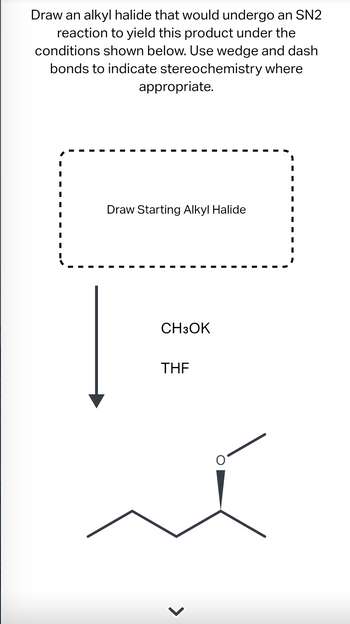
Chemistry
10th Edition
ISBN: 9781305957404
Author: Steven S. Zumdahl, Susan A. Zumdahl, Donald J. DeCoste
Publisher: Cengage Learning
expand_more
expand_more
format_list_bulleted
Question
thumb_up100%

Transcribed Image Text:Draw an alkyl halide that would undergo an SN2
reaction to yield this product under the
conditions shown below. Use wedge and dash
bonds to indicate stereochemistry where
appropriate.
Draw Starting Alkyl Halide
CH3OK
THE
Expert Solution
This question has been solved!
Explore an expertly crafted, step-by-step solution for a thorough understanding of key concepts.
This is a popular solution
Trending nowThis is a popular solution!
Step by stepSolved in 2 steps with 2 images

Knowledge Booster
Learn more about
Need a deep-dive on the concept behind this application? Look no further. Learn more about this topic, chemistry and related others by exploring similar questions and additional content below.Similar questions
- Propose a multi-step synthesis of the target molecule shown at the right, using the starting materials on the left and any other reagents you need. Show the reagents needed for each step and the product of each step. You will need 4 reaction arrows. Remember: Aldehyde + terminal alkyne anion in acid = alcoholarrow_forwardWhat is a multi-step synthesis for the following:arrow_forwardProvide the product(s) for the following reaction. If no reaction, draw the starting materials.arrow_forward
- Draw the major product of this reaction. Ignore inorganic byproducts. H3O*arrow_forwardhelp #10arrow_forwardA bacteria produces an aromatic product starting with the enolate shown below.Step 1. An aldol condensation reaction.Step 2. Two keto-enol tautomerizations.Step 3. Ester hydrolysis followed by decarboxylation. Draw the structure of the final product with formula C11H16O2arrow_forward
- Complete these SN2 reactions, showing the configuration of each product.arrow_forwardWhich best explains the following reaction. OH OH H3O+ This reaction does not work because the major product would be an alkene formed by elimination. This reaction does not work because the major product would be an ester. This reaction does not work because three ethers can be formed. This reaction works and the only ether product formed is shown. +arrow_forwardShow how the Wittig reaction might be used to prepare the following alkene. Draw the alkyl bromide and the carbonyl compound that you would use. H3C CH, • You do not have to consider stereochemistry. • You do not have to explicitly draw H atoms. • Do not include lone pairs in your answer. They will not be considered in the grading. • In cases where there is more than one answer, just give one. • Draw one structure per sketcher. Add additional sketchers using the drop-down menu in the bottom right corner. • Separate multiple reactants using the + sign from the drop-down menu.arrow_forward
- Draw one product of an elimination reaction between the molecules below. Note: There may be several correct answers. You only need to draw one of them. You do not need to draw any of the side products of the reaction. o* o Br SH Ö + X Click and drag to start drawing a structure.arrow_forwardQ4. Alkyl halides are good at doing substitution (SN2/SN1) and elimination (E1/E2) reactions because the halide (X-) is a good LG. Alcohols on the other hand are not suitable for these reactions since hydroxide (¯OH) is a poor LG. However, an OH can be converted into a OTs (tosyl group) by reacting an alcohol with TsCl in presence of a base. An OTs is a good LG, and this allows us to indirectly (via OTs) use alcohols in substitution (SN2/SN1) and elimination (E1/E2) reactions. (4) OH TsCl NEt3 OTS Tosyl ester NaCN DMSO + HNEt3 Determine the major/minor products CH3OH heat OTS Tosyl ester TsCl = NaOCH3 CH3OH DBU Ś=0 CIarrow_forwardI need help drawing the product of this reaction. The starting material is vanillin and it is being treated with SO3 & H2SO4 in order to generate a product with the formula C8H8SO6.arrow_forward
arrow_back_ios
SEE MORE QUESTIONS
arrow_forward_ios
Recommended textbooks for you
 ChemistryChemistryISBN:9781305957404Author:Steven S. Zumdahl, Susan A. Zumdahl, Donald J. DeCostePublisher:Cengage Learning
ChemistryChemistryISBN:9781305957404Author:Steven S. Zumdahl, Susan A. Zumdahl, Donald J. DeCostePublisher:Cengage Learning ChemistryChemistryISBN:9781259911156Author:Raymond Chang Dr., Jason Overby ProfessorPublisher:McGraw-Hill Education
ChemistryChemistryISBN:9781259911156Author:Raymond Chang Dr., Jason Overby ProfessorPublisher:McGraw-Hill Education Principles of Instrumental AnalysisChemistryISBN:9781305577213Author:Douglas A. Skoog, F. James Holler, Stanley R. CrouchPublisher:Cengage Learning
Principles of Instrumental AnalysisChemistryISBN:9781305577213Author:Douglas A. Skoog, F. James Holler, Stanley R. CrouchPublisher:Cengage Learning Organic ChemistryChemistryISBN:9780078021558Author:Janice Gorzynski Smith Dr.Publisher:McGraw-Hill Education
Organic ChemistryChemistryISBN:9780078021558Author:Janice Gorzynski Smith Dr.Publisher:McGraw-Hill Education Chemistry: Principles and ReactionsChemistryISBN:9781305079373Author:William L. Masterton, Cecile N. HurleyPublisher:Cengage Learning
Chemistry: Principles and ReactionsChemistryISBN:9781305079373Author:William L. Masterton, Cecile N. HurleyPublisher:Cengage Learning Elementary Principles of Chemical Processes, Bind...ChemistryISBN:9781118431221Author:Richard M. Felder, Ronald W. Rousseau, Lisa G. BullardPublisher:WILEY
Elementary Principles of Chemical Processes, Bind...ChemistryISBN:9781118431221Author:Richard M. Felder, Ronald W. Rousseau, Lisa G. BullardPublisher:WILEY

Chemistry
Chemistry
ISBN:9781305957404
Author:Steven S. Zumdahl, Susan A. Zumdahl, Donald J. DeCoste
Publisher:Cengage Learning

Chemistry
Chemistry
ISBN:9781259911156
Author:Raymond Chang Dr., Jason Overby Professor
Publisher:McGraw-Hill Education

Principles of Instrumental Analysis
Chemistry
ISBN:9781305577213
Author:Douglas A. Skoog, F. James Holler, Stanley R. Crouch
Publisher:Cengage Learning

Organic Chemistry
Chemistry
ISBN:9780078021558
Author:Janice Gorzynski Smith Dr.
Publisher:McGraw-Hill Education

Chemistry: Principles and Reactions
Chemistry
ISBN:9781305079373
Author:William L. Masterton, Cecile N. Hurley
Publisher:Cengage Learning

Elementary Principles of Chemical Processes, Bind...
Chemistry
ISBN:9781118431221
Author:Richard M. Felder, Ronald W. Rousseau, Lisa G. Bullard
Publisher:WILEY